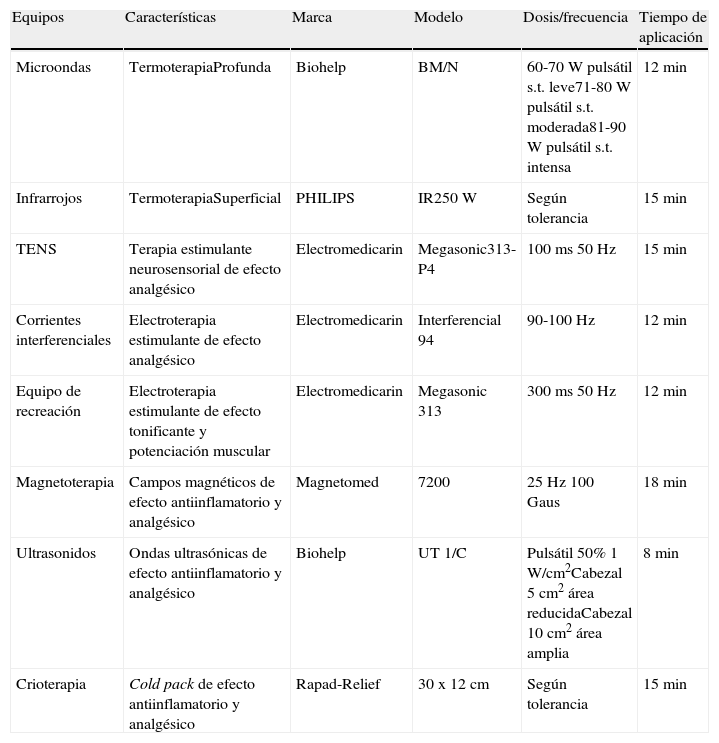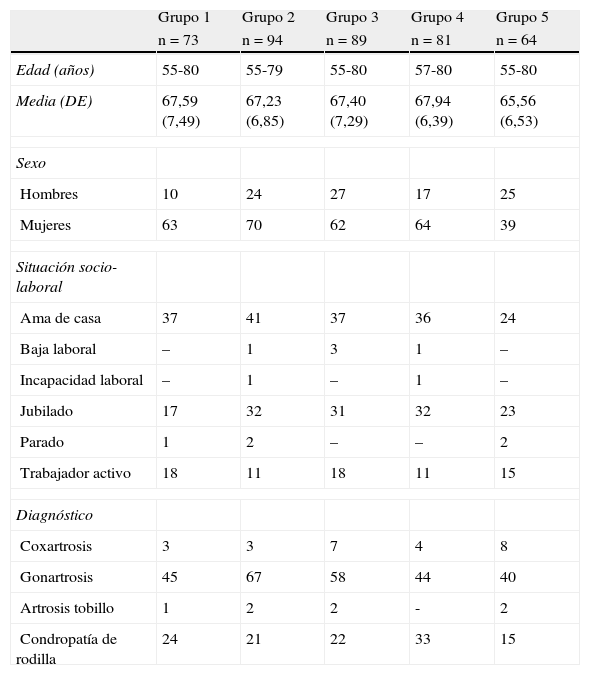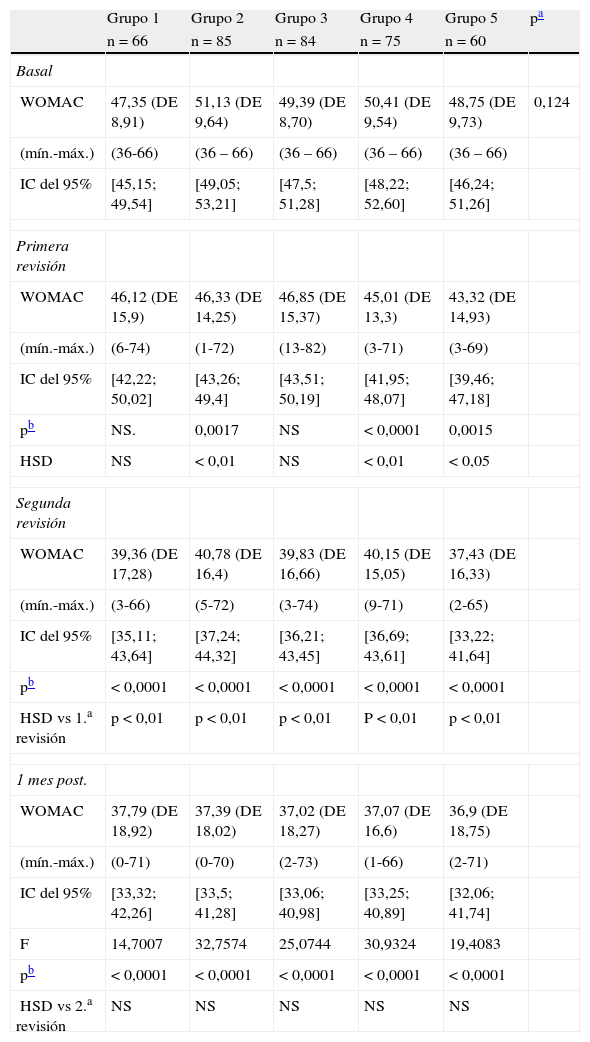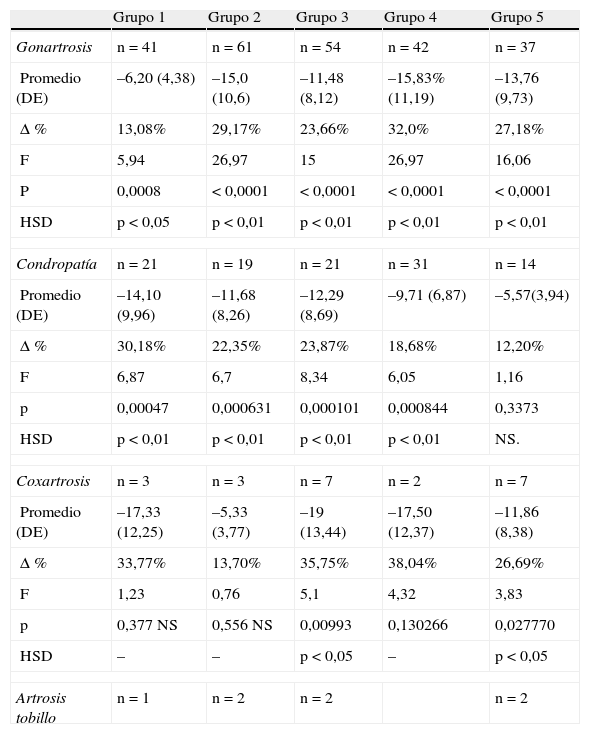Se pretende comparar los resultados obtenidos con la aplicación de termoelectroterapia, cinesiterapia y la combinación de ambas técnicas a fin de establecer cuáles aportan un mayor beneficio terapéutico.
Material y métodosEstudio longitudinal, provocado y aleatorizado. Entre septiembre 2007 y diciembre del 2009, 370 pacientes con osteoartritis (OA) de extremidades inferiores fueron asignados aleatoriamente a 5 grupos de estudio: el grupo 1 recibió termoelectroterapia doble; el grupo 2, cinesiterapia + termoelectroterapia; el grupo 3, cinesiterapia + ejercicios propioceptivos + termoelectroterapia; el grupo 4, terapia manual + cinesiterapia + electroterapia, y el grupo 5 recibió terapia grupal de ejercicios TRAL®. Se evaluó el estado funcional con la escala global WOMAC tras 31 sesiones de terapia fisioterapéutica en 4 momentos: basal, 15 sesiones, 31 sesiones y 1 mes post-tratamiento.
ResultadosTodos los grupos experimentaron mejorías estadísticamente significativas al final del tratamiento (p < 0,0001) en un porcentaje superior al 20%. Por grupos, el grupo 5 experimentó mayor mejoría mientras duró el tratamiento, mientras que los grupos combinados de ejercicio más agentes físicos siguieron mejorando tras finalizar las sesiones. Por diagnósticos, las condropatías de rodilla respondieron mejor al tratamiento con termoelectroterapia (grupo 1) y las gonartrosis y coxartrosis al ejercicio físico (grupo 5).
ConclusionesEl tratamiento fisioterapéutico de la OA de extremidades inferiores aporta una mejoría clínica importante del estado funcional. El ejercicio físico es la piedra angular de la terapia, si bien requiere de la adhesión y corresponsabilidad del paciente al programa de ejercicios. La termoelectroterapia tiene un efecto favorecedor de la mejoría sugiriendo un beneficio adicional.
We have compared the results from thermoelectric therapy, exercise therapy and the combination of both techniques in order to establish which ones provide the best therapeutic results.
Material and methodsA longitudinal, randomized study was performed from September 2007 to December 2009. A total of 370 patients with osteoarthritis (OA) of the lower limbs were randomized into the five study groups. Group 1 received double thermoelectric therapy; group 2, exercise therapy + thermoelectric therapy; group 3, exercise therapy + propioceptive exercise + thermoelectric therapy; group 4, manual therapy + exercise therapy + thermoelectric therapy; group 5 team TRAL® therapy. The functional status was assessed with the WOMAC global scale after 31 sessions of physiotherapy in 4 different times: at baseline, at 15 sessions, at 31 sessions and at 1 month after treatment.
ResultsAll the groups showed statistically significant improvements at endpoint (P<.0001) at a rate above 20%. By groups, Group 5 showed the greatest improvement during treatment, while groups with combined exercise plus physical agents have continued to improve after completing the sessions. By diagnoses, knee chondropathies responded better to treatment with thermoelectric therapy (group 1) while gonarthrosis and coxarthrosis responded better to the physical exercise of group 5.
ConclusionsPhysiotherapy of OA of the lower limbs provided a significant clinical improvement of the patient's functional status. Exercise is the cornerstone of therapy, but requires the commitment and responsibility of the patient towards the exercise program. Thermoelectric therapy has a favorable effect on improvement, suggesting an additional benefit.
Artículo
Si ya tiene sus datos de acceso, clique aquí.
Si olvidó su clave de acceso puede recuperarla clicando aquí y seleccionando la opción "He olvidado mi contraseña".Comprando el artículo el PDF del mismo podrá ser descargado
Precio 19,34 €
Comprar ahora














